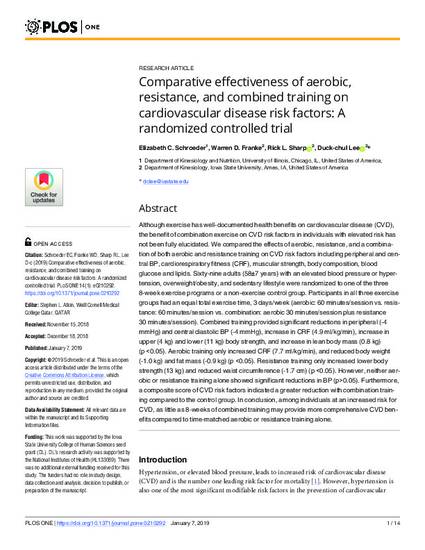
Although exercise has well-documented health benefits on cardiovascular disease (CVD), the benefit of combination exercise on CVD risk factors in individuals with elevated risk has not been fully elucidated. We compared the effects of aerobic, resistance, and a combination of both aerobic and resistance training on CVD risk factors including peripheral and central BP, cardiorespiratory fitness (CRF), muscular strength, body composition, blood glucose and lipids. Sixty-nine adults (58±7 years) with an elevated blood pressure or hypertension, overweight/obesity, and sedentary lifestyle were randomized to one of the three 8-week exercise programs or a non-exercise control group. Participants in all three exercise groups had an equal total exercise time, 3 days/week (aerobic: 60 minutes/session vs. resistance: 60 minutes/session vs. combination: aerobic 30 minutes/session plus resistance 30 minutes/session). Combined training provided significant reductions in peripheral (-4 mmHg) and central diastolic BP (-4 mmHg), increase in CRF (4.9 ml/kg/min), increase in upper (4 kg) and lower (11 kg) body strength, and increase in lean body mass (0.8 kg) (p <0.05). Aerobic training only increased CRF (7.7 ml/kg/min), and reduced body weight (-1.0 kg) and fat mass (-0.9 kg) (p <0.05). Resistance training only increased lower body strength (13 kg) and reduced waist circumference (-1.7 cm) (p <0.05). However, neither aerobic or resistance training alone showed significant reductions in BP (p>0.05). Furthermore, a composite score of CVD risk factors indicated a greater reduction with combination training compared to the control group. In conclusion, among individuals at an increased risk for CVD, as little as 8-weeks of combined training may provide more comprehensive CVD benefits compared to time-matched aerobic or resistance training alone.
Available at: http://works.bepress.com/duck-chul_lee/53/

This article is published as Schroeder EC, Franke WD, Sharp RL, Lee D-c (2019) Comparative effectiveness of aerobic, resistance, and combined training on cardiovascular disease risk factors: A randomized controlled trial. PLoS ONE 14(1): e0210292. doi: 10.1371/journal.pone.0210292.